None
Most users ever online was 387 on Tue Dec 05, 2023 7:35 pm
The newest registered user is Skylines3
Our users have posted a total of 47502 messages in 4941 subjects
| No user |
• The FREE hand reading services at the Modern Hand Reading Forum are being continued in 2019 with the assistance of Google adsense!

Learn how to read hands according the Modern Hand Reading paradigm & you can use this forum as your palm reading guide!
DOWN SYNDROME - The language of the hands!
Modern Hand Reading Forum - Discover the language of your hands: palm reading & palmistry forum! :: III - MODERN HAND READING - Various systems for reading hands! :: IIIa - Modern Palmistry: general topics, questions :: IIIf - (Scientific) Multi-Perspective Palm Reading
 DOWN SYNDROME - The language of the hands!
DOWN SYNDROME - The language of the hands!

A 'phantom picture' for the hand in Down syndrome (incl. anthropometric data).
Multi-Perspective Palm Reading describes the full perspective of the hand in Down syndrome: 6 out of the 7 hand-perspectives are involved, though it's possible to make a reliable hand-diagnosis with only the dermatoglyphics, hand shape & finger morphology!
Down syndrome, is a genetic disorder that is featured with a trisomy (= an extra chromosome) on the 21th chromosome, see picture below. Studying the hand in Down syndrome is an excellent exercise to learn more about how hands can be used reliably as a diagnostic tool in a medical perspective.

Multi-Perspective Palm Reading describes via other themes how via a likewise systematic approach the hand can be used for the same purpose in the field of psychiatry & psychology.
An overview of various articles about the hand in Down syndrome:
• How does a doctor use hands for recognizing Down syndrome?:
http://palmreadingperspectives.wordpress.com/2011/05/30/how-to-diagnose-down-syndrome-from-the-hands-only/
• Multi-Perspective Palm Reading: an introduction to hands & Down syndrome:
http://www.multiperspectivepalmreading.com/hands-down-syndrome-palm-reading.htm
• How to make a Palm Reading assessment for Down's syndrome:
http://www.handresearch.com/diagnostics/simian-line-down-syndrome.htm
The following picture can be used as a point of reference to recognize the essential diffferences between the hand in Down syndrome & the normal hand:
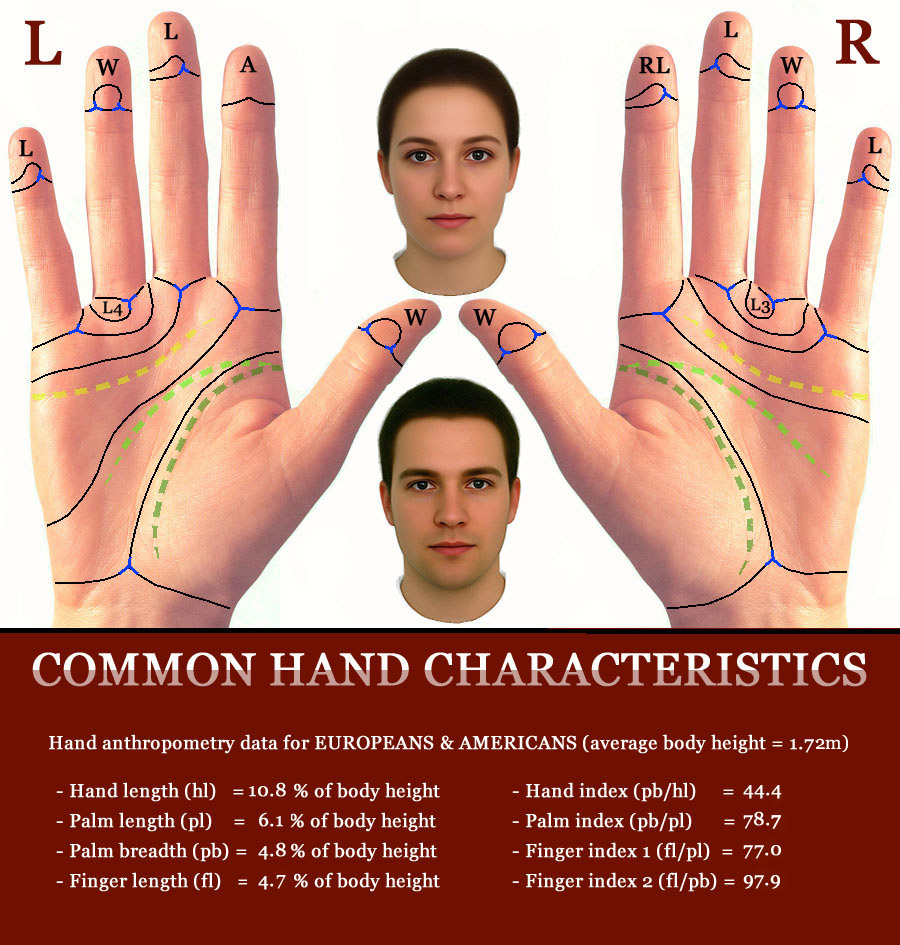
Last edited by Martijn (admin) on Sat Jun 04, 2011 9:28 pm; edited 1 time in total
 Re: DOWN SYNDROME - The language of the hands!
Re: DOWN SYNDROME - The language of the hands!
The 3th article e.g. presents an over view of 27 key-elements of the hand in Down syndrome. But the most essential hand characteristics are summarized as follows:
"Key-elements of the hand in Down's syndrome in a nutshell: small hands with squarish palm shape, short fingers, short fingernails, palm & fingers display typical dermatoglyphics (usually featured with high positioned axial triradius on hypothenar), unusual palmar creases (very often featured with simian crease or Sydney line)."
PS. The article also includes a ''phantom picture' for the hand in Down syndrome describing the 27 characteristics:

 Re: DOWN SYNDROME - The language of the hands!
Re: DOWN SYNDROME - The language of the hands!
(... Trying to dig a little deeper into the fundamentals of Down syndrome)
I have now also created a TOP 10 of most significant hand signs in Down syndrome:
THE TOP 10 HAND SIGNS FOR
RECOGNIZING DOWN SYNDROME
(Ranked by 'Log Odds Ratio' = LOR)
I - Single crease on 5th finger [Log Odds Ratio = 4.87+]
II - Ridge line A ends above heart line [Log Odds Ratio = 4.07+]
III - AtD angle is 57 degrees or higher [Log Odds Ratio = 3.96+]
IV - Hyperflexible finger joints [Log Odds Ratio = 3.58+]
V - Multiple palmar ridge dissociation [Log Odds Ratio = 3.18+]
VI - Large ulnar loops on hypothenar [Log Odds Ratio = 3.02+]
VII - Simian crease [Log Odds Ratio = 2.69+]
VIII - Brachydactly [Log Odds Ratio = 2.50+]
IX - Fingerprint: radial loop on ring finger [Log Odds Ratio = 2.46+]
X - 3 Or more triradii on hypothenar [Log Odds Ratio = 2.32+]
I think it is quite fascinating to see that 4 features in this list point out to the 'mount of Moon' (= the palmar hypothenar zone) - which appears to play a key role in how to recognize Down syndrome from a hand.
The list also shows that 'multiple perspectives' of the hand are involved: the list includes dermatoglyphic & line characteristics which relate to the palm & fingers (e.g. single crease on the fifth finger + simian crese).
And additionally, the size of the fingers is also present among this TOP 10 (e.g. brachydactyly = extremely short fingers).
More details are presented at this page:
http://www.handresearch.com/diagnostics/simian-line-down-syndrome.htm
Last edited by Martijn (admin) on Tue Jul 16, 2013 9:36 pm; edited 2 times in total
 Re: DOWN SYNDROME - The language of the hands!
Re: DOWN SYNDROME - The language of the hands!
 Re: DOWN SYNDROME - The language of the hands!
Re: DOWN SYNDROME - The language of the hands!
Ron wrote:How can you haven't mentioned in any of the factors presented in PDC?
Hi Ron,
I am not sure what you exactly have in mind...?
PS. PDC is not designed for assessing inborn syndromes, nor acquired severe medical- and or psychiatric disorders. But you are welcome to specify your thoughts.
 Re: DOWN SYNDROME - The language of the hands!
Re: DOWN SYNDROME - The language of the hands!
 Re: DOWN SYNDROME - The language of the hands!
Re: DOWN SYNDROME - The language of the hands!
Hi Ron,
Thanks for explaining what you have in mind. Holtzman indeed describes that he has noticed that thumb dislocation (his 'primary fault factor') is frequently seen in retared individuals.
But retardation can have many causes. And though Down syndrome is the most common cause of mental retardation, thumb dislocation does not belong to it's common features.
From my sample I can report that only a small minority of people with Down syndrome have this thumb characteristic.
(Sorry, I have no representative statistics for this hand characteristic, but so far I have seen no reports at all which point out the significance of this characteristic in Down syndrome. And because Holtzman also does not mention Down syndrome specificly, this can only implicate that this thumb characteristic is unlikely to rank high in the long list of hand characteristics for Down syndrome).
I hope this now makes sense!?

PS. Did you have any other hand features in mind?
 Re: DOWN SYNDROME - The language of the hands!
Re: DOWN SYNDROME - The language of the hands!
Ron wrote:Well the features of the Primary Fault Factor indicates downsyndrome, as one of many in the PDC textbook.
Ron, I've re-read this chapter but can't find where Arnold says anything about it indicates Down Syndrome?
I didn't notice anything in Martijn's list about the thumb, but in my experience many people who have Down's syndrome have a short and STIFF thumb.... and strong willpower to go with it! kind-of opposite of flexible dislocated type illustrated in "Primary Fault Factor"?
 Re: DOWN SYNDROME - The language of the hands!
Re: DOWN SYNDROME - The language of the hands!
Hi Lynn,
While the 'short (low set) thumb' is known as a typical characteristic in Down syndrome, I only found a study reporting a percentage of 20%. Which implicates that it probably doesn't belong in the TOP 10 of the most significant hand signs in Down syndrome.
(My estimate is that a short thumb is also seen in a considerable percentage of the general population... possibly somewhere around 5%).

 Re: DOWN SYNDROME - The language of the hands!
Re: DOWN SYNDROME - The language of the hands!
... In one of my earlier posts I mentioned that 'short fingers' [technically named: brachydactyly] belongs to the TOP 10 essential hand features in Down syndrome.
The picture below presents detailed guidelines in order to recognize this feature in Down syndrome (by using a new concept: the 'finger length index').
(More details are presented in this brand new section about finger length)
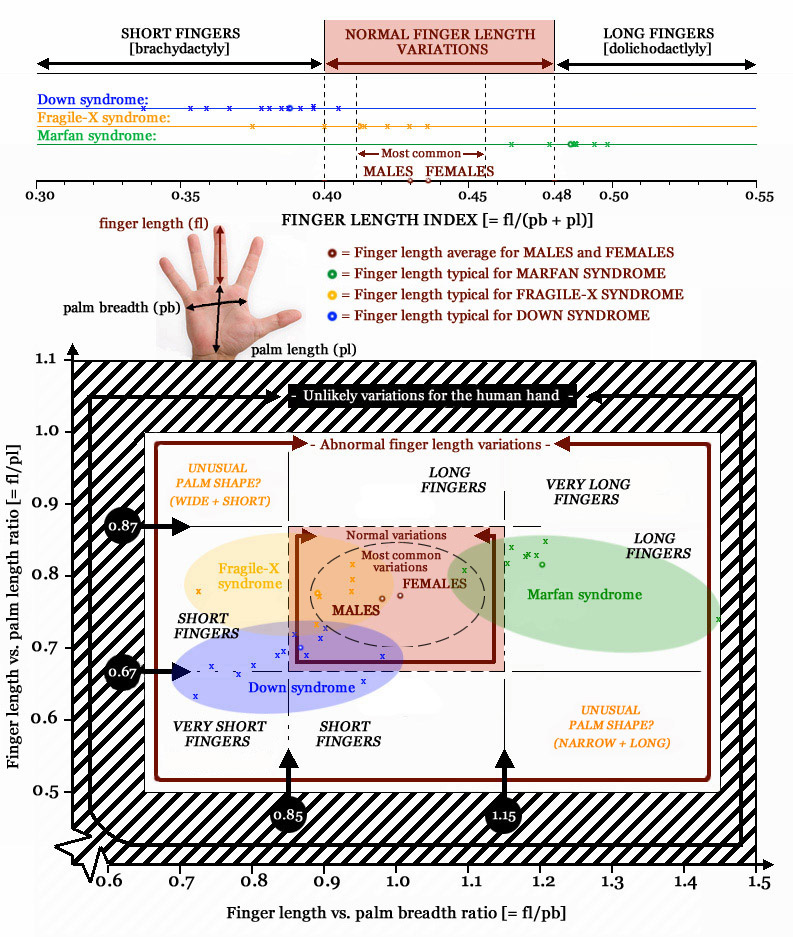
 Re: DOWN SYNDROME - The language of the hands!
Re: DOWN SYNDROME - The language of the hands!
... In one of my earlier posts I mentioned that a 'radial loop on the ring finger' belongs to the TOP 10 essential hand features in Down syndrome.
Now I have a picture available which shows the larger perspective (see below): in Down syndrome radial loops are actually less common (compared to the general population), but the most stricking aspect is that radial loops in Down syndrome display a very different distribution across the five fingers:
In the general population radial loops usually (in about 80% of cases) manifest on the index finger;
however, in Down syndrome the ring finger and the pinky tend to have about 75% of all radial loops
(More details are presented in this new article about radial loops: http://www.handresearch.com/news/10-facts-about-radial-loop-fingerprints.htm )
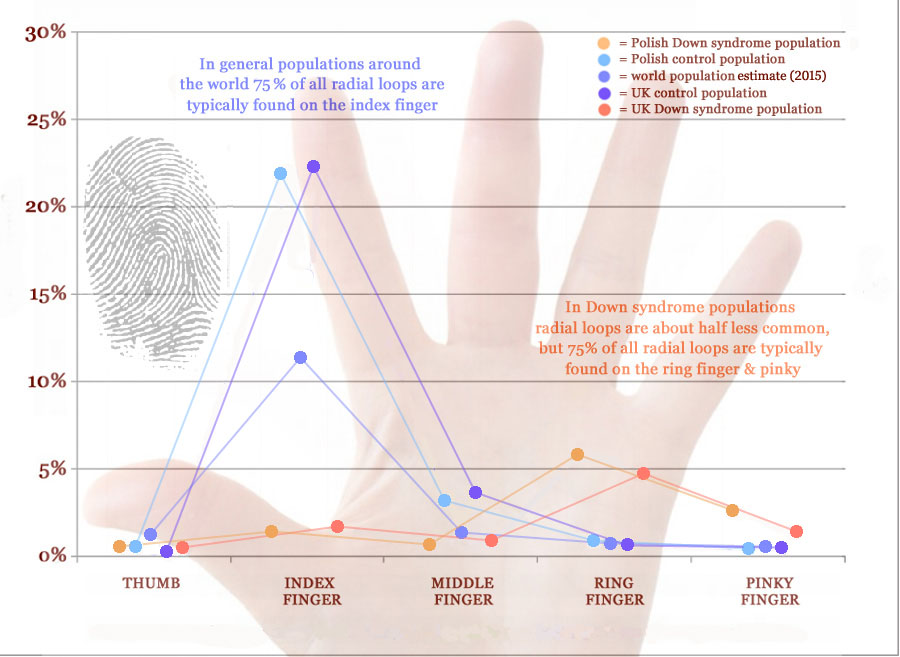
 Re: DOWN SYNDROME - The language of the hands!
Re: DOWN SYNDROME - The language of the hands!
Update - Discover how the two new rules in Multi-Perspective Palm Reading work out in Down syndrome:
according Multi-Perspective Palm Reading!
Rule no.1 - Significant major perspectives in Down syndrome:
Function - Proportion - Skin - Palm - Fingers (= 5 out of 5)
Rule no.2 - Most significant minor level in Down syndrome:
Dermatoglyphics (= level 8)
Down syndrome (trisomy 21) is a genetic disorder caused by the presence of a trisomy on chromosome 21. The hand system in Down syndrome varies always in at least 4 out of the 5 major perspectives from the hand in ordinary people; the proportion & skin in both the palm and the fingers are always involved. But usually the 1st major perspective - function - also gets involved with hyperextensible finger joints, a charteristic that relates to flexible hand motorics which is very commonly present in Down syndrome.
Full article:
Down syndrome & the hand system according Multi-Perspective Palm Reading!
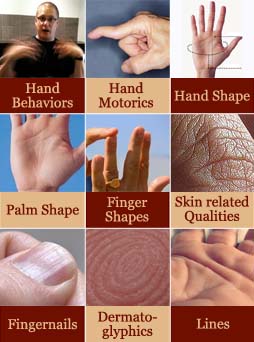
 Re: DOWN SYNDROME - The language of the hands!
Re: DOWN SYNDROME - The language of the hands!
New article: Scientific hand charts for Down syndrome!
(Some of the article's illustrations are taken from the scientific literature & displayed below)
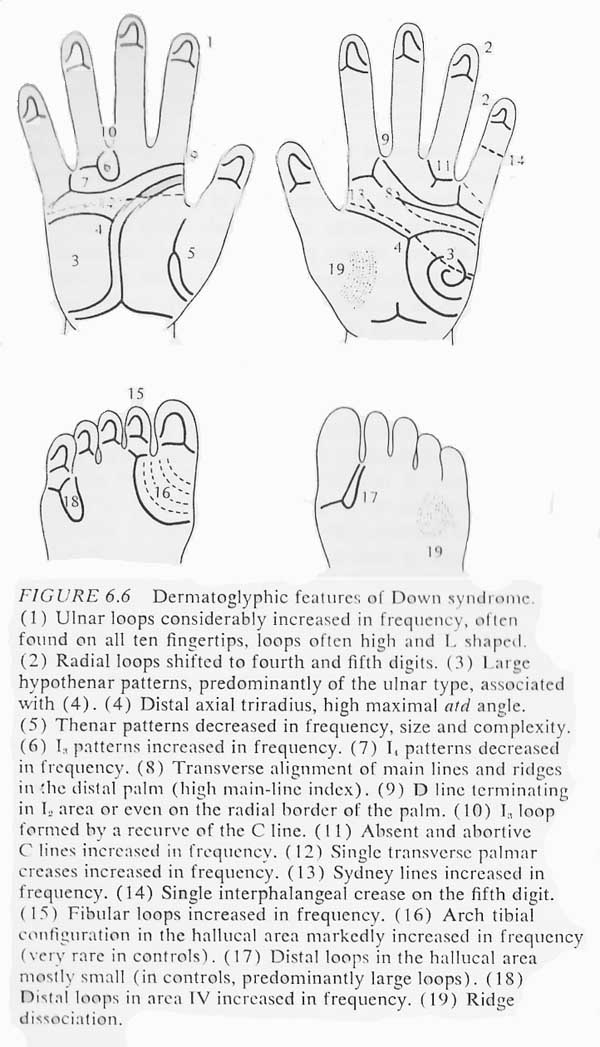
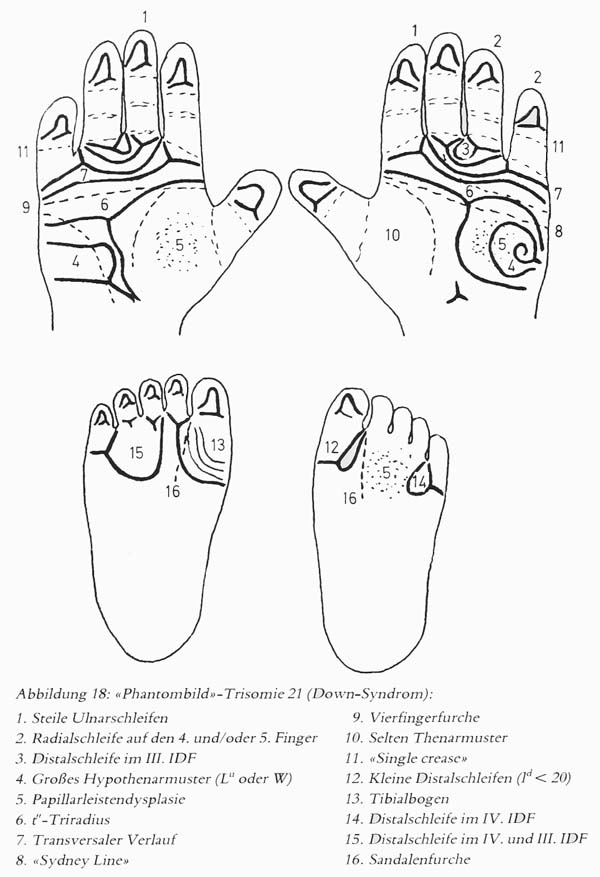


 Re: DOWN SYNDROME - The language of the hands!
Re: DOWN SYNDROME - The language of the hands!
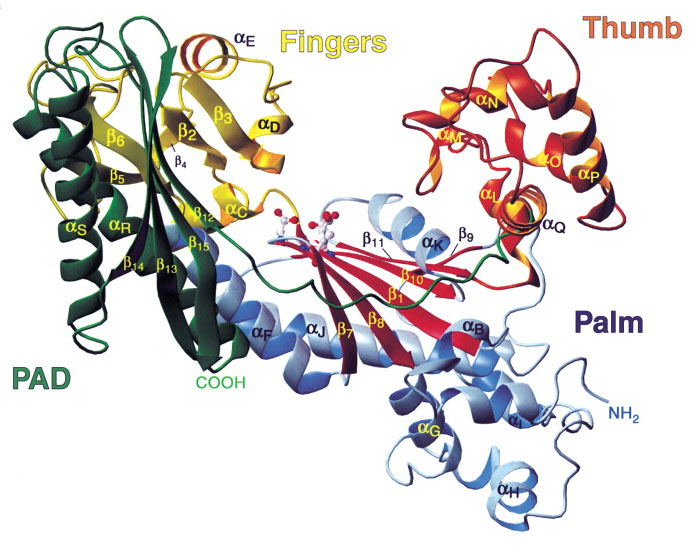
The following quick summary describes the most significant hand signs in Down syndrome (taken from the article presented at the bottom of this post):
"• [4]: Trisomy 21 (= Down syndrome):
Summary of the most significant hand signs in Down syndrome:
- Hand level 2: hyperextensible finger joints.
- Hand level 3: short, broad hands.
- Hand level 4: broad palm.
- Hand level 5: short fingers, very short 5th finger, clinodactyly of the 5th finger.
- Hand level 8: usually all- or the large majority of fingerprints display an ulnar loop (10 likewise fingerprint patterns represent 'monomorphic hands'), often a radial loop is found on the 4th finger and/or 5th finger; the palm typically bares a pattern in interdigital zone 3 + the hypothenar, with the latter usually featured with a high positioned axial triradius (featured with a high AtD angle) often combined with an ulnar loop.
- Hand level 9: single palmar crease (a.k.a simian crease), single interphalangeal crease on pinky is sometimes present."
More summaries for 36+ other conditions:
Decoding the language of the hand: how to find 36 conditions with just 54 major hand signs!!
(The table below provides an easy opportunity to find the most significant hand sign combinations for a specific condition; the table also represents the foundation of this masterclass mini-course in scientific hand reading)
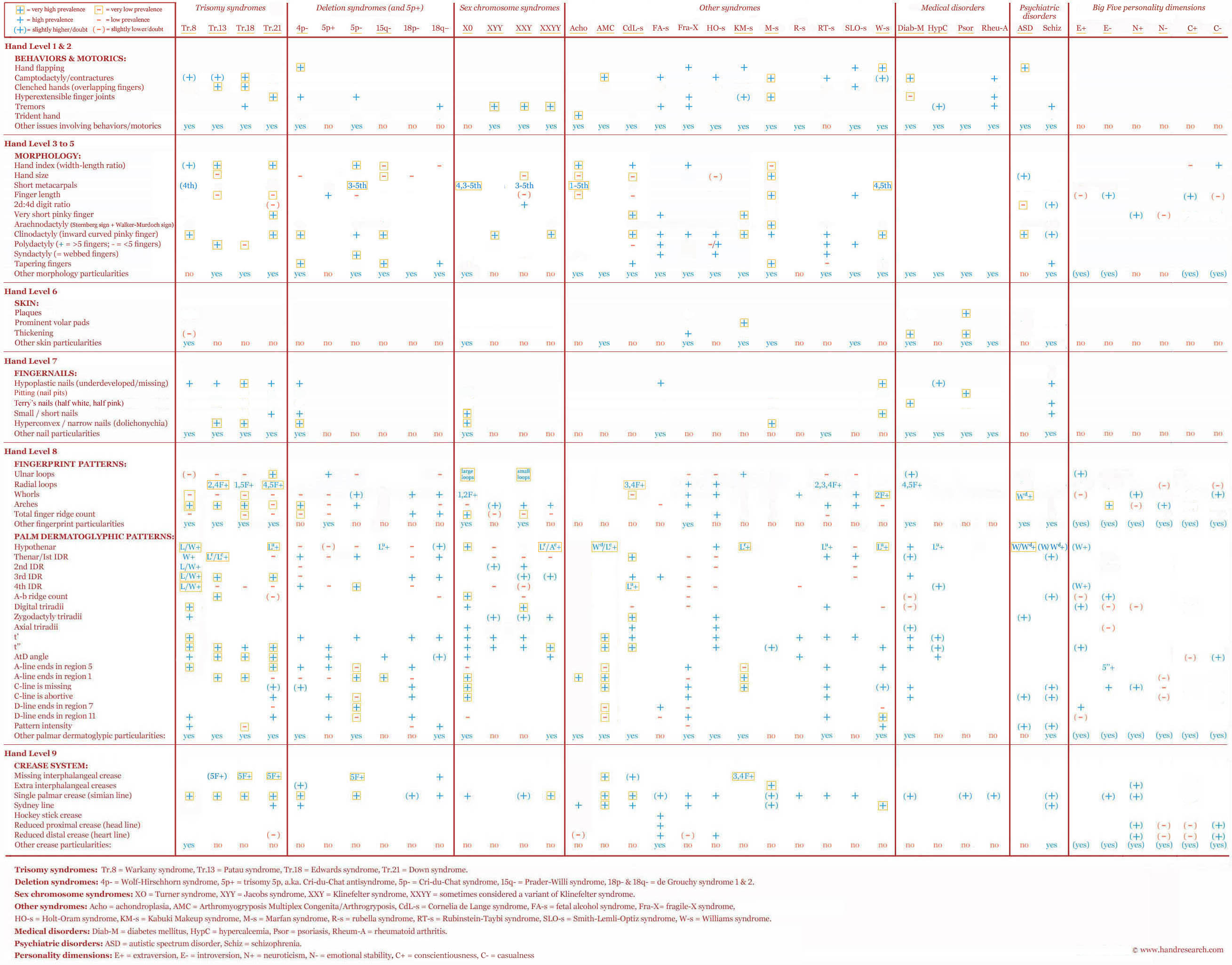
 Similar topics
Similar topics» SCHIZOPHRENIA - The language of the hands!
» BLOG REPORT: "Little hands" (Down's syndrome)
» 'In My Hands' - A Story of Marfan syndrome (documentary)
» JEREMY BEADLE'S HANDS - King of jokes had a small little baby hand! (Poland syndrome)
Modern Hand Reading Forum - Discover the language of your hands: palm reading & palmistry forum! :: III - MODERN HAND READING - Various systems for reading hands! :: IIIa - Modern Palmistry: general topics, questions :: IIIf - (Scientific) Multi-Perspective Palm Reading






» Teacher square on my Jupiter mount
» Handreading International Conference 2024
» Can anyone read it for me?
» Are there any signs in the hands that you are a twin flame?
» Square on Marriage line
» Cross in mount Jupiter
» clinodactyly: top phalanges bending towards Mercury finger
» Can anybody please read this hand
» Nisha Ghai
» Absolutely non-sense career till now
» Fate Destiny Line -
» VIII - Palmistry books TOP 100 - listed by 'Amazon Sales Rank'!
» Stewart Culin - Palmistry in China and Japan
» Herbert Giles - Palmistry in China